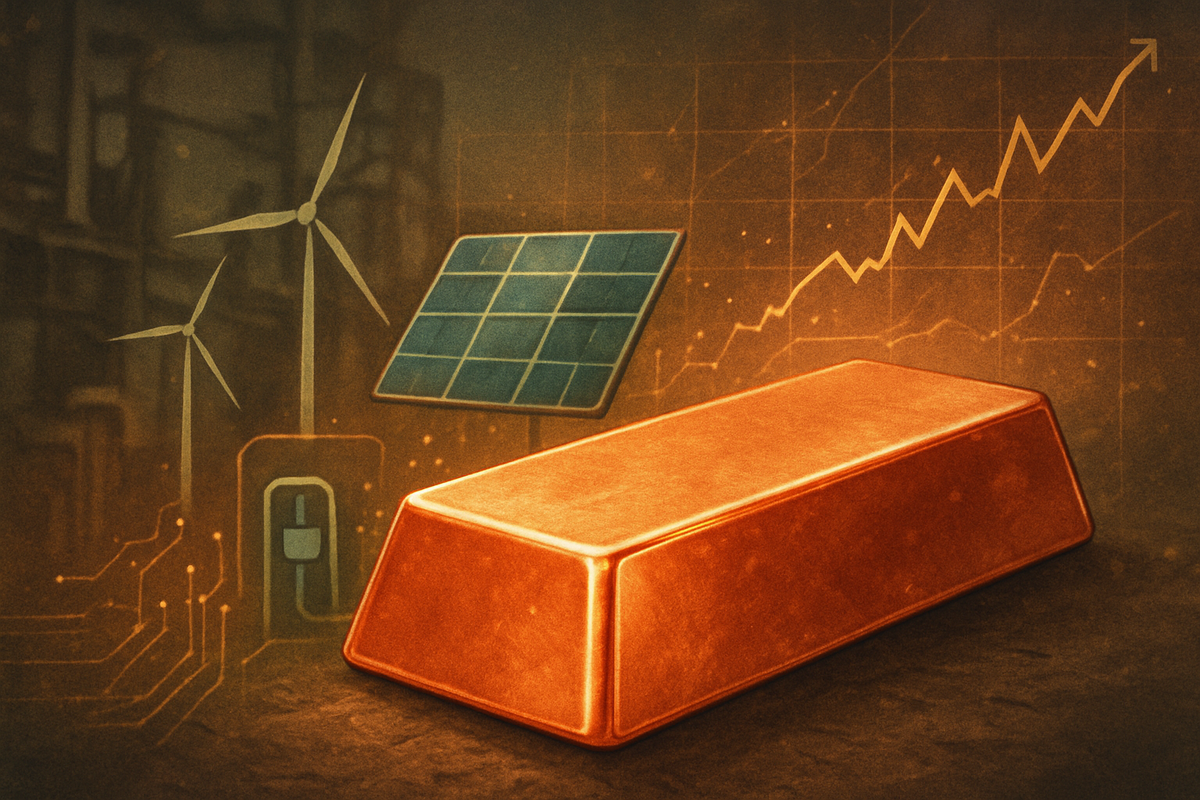
The global industrial metals market, particularly copper, finds itself at a pivotal juncture in November 2025, characterized by a powerful collision of surging demand from the green energy transition and persistent supply constraints. This dynamic has led to significant price volatility throughout the year, with copper experiencing both record highs and sharp corrections, ultimately solidifying its role as a critical commodity for the future economy. The ongoing interplay between robust demand drivers, strategic geopolitical maneuvers, and an increasingly challenged supply side is setting the stage for a prolonged period of elevated prices and strategic re-evaluation for industries worldwide.
As the world aggressively pursues decarbonization and technological advancement, copper has emerged as an indispensable metal, integral to everything from electric vehicles (EVs) and renewable energy infrastructure to advanced AI data centers. However, the enthusiasm for this "red metal" is tempered by a looming supply deficit, exacerbated by underinvestment in new mines, declining ore grades, and recent operational disruptions. This imbalance is not merely a short-term market fluctuation but indicative of a deeper structural shift that promises to reshape global supply chains and investment strategies for decades to come.
The Red Metal's Rollercoaster: Tariffs, Deficits, and Critical Status
The year 2025 has been a tumultuous one for copper prices, marked by dramatic swings and significant policy shifts. In July, COMEX copper prices soared to an unprecedented US$5.81 per pound, fueled by fears surrounding potential US tariffs on imports. This surge was short-lived, however, as prices rapidly retreated to US$4.37 per pound in early August once the tariff details became clearer. Despite this volatility, copper regained momentum, approaching US$5 per pound by early October and reaching $11,094 per tonne on the London Metal Exchange (LME) and $5.247 per pound on COMEX in early November. As of November 14, 2025, LME copper settled slightly lower at $10,865 per ton (approximately $4.93 per pound) following slower economic data from China, yet it remains on track for weekly gains. Overall, copper prices have risen over 20% year-to-date in 2025, underscoring the underlying bullish sentiment.
A major event contributing to the market's turbulence was the Trump administration's July 2025 announcement of a 50% tariff on US copper imports. This policy immediately triggered a "front-loading" phenomenon, with buyers accelerating physical shipments into the US during Q3 to pre-empt the tariffs, leading to an unprecedented build-up of inventory. This temporary glut in the US is expected to unwind in the latter half of 2025, initiating a destocking cycle that could divert supply to other regions and exert downward pressure on LME prices in the short term. Simultaneously, the supply side has been plagued by persistent challenges, including declining ore grades (eroding 0.5-1% annually), chronic underinvestment in new mine development over the past decade, and operational disruptions at major assets like Kamoa-Kakula and Grasberg in Q3 2025. These factors have led to significant downward revisions in supply forecasts, with analysts predicting potential copper deficits of up to 500,000 tons by 2025 and an alarming 10 million tonnes annually by 2030 if demand continues its current trajectory.
Adding to copper's strategic importance, the U.S. Geological Survey officially designated copper as a "critical mineral" on November 6, 2025. This reclassification elevates copper's standing, potentially unlocking policy incentives, financing mechanisms, and trade prioritization for domestic copper projects, signaling a clear intent to secure future supply. Key players in this evolving landscape include major mining companies grappling with geological and operational hurdles, governments implementing trade policies and critical mineral strategies, and industries across the energy, automotive, and technology sectors heavily reliant on a stable and affordable copper supply. China, as the world's largest consumer and a major refined copper producer, remains a pivotal stakeholder, with its economic performance and urbanization initiatives profoundly influencing global demand and prices. The initial market reaction to these developments has been one of heightened volatility, reflecting the complex interplay of fundamental supply-demand dynamics, geopolitical risks, and strategic national interests.
Winners and Losers in the Copper Boom
The current state of the industrial metals market, particularly copper's robust demand and constrained supply, creates clear winners and potential challenges for various public companies. Leading the charge among the beneficiaries are major copper mining companies. Firms like Freeport-McMoRan (NYSE: FCX), Rio Tinto (ASX: RIO), and BHP (ASX: BHP) are poised to see increased revenues and profitability from elevated copper prices. Their existing assets become significantly more valuable, and the incentive to invest in expanding production or developing new projects grows stronger. However, they must also navigate rising production costs due to inflation, energy prices, and the shift to cleaner production technologies, as well as the long lead times and high capital expenditure required for new mine development.
Beyond the direct miners, companies heavily invested in the global energy transition stand to benefit from the sustained demand for copper. Manufacturers of electric vehicles, such as Tesla (NASDAQ: TSLA) and BYD (HKEX: 1211), and renewable energy infrastructure developers, including wind turbine manufacturers like Vestas Wind Systems (CPH: VWS) and solar panel producers, will find their products increasingly in demand. While they face higher input costs for copper, their market growth is fundamentally tied to the very trends driving copper demand. Their success will depend on their ability to secure stable copper supply chains and pass on increased material costs to consumers, or innovate to reduce copper intensity.
Conversely, companies in traditional manufacturing sectors that rely on copper but operate with tighter margins may face significant headwinds. Industries that cannot easily pass on increased raw material costs to their customers could see their profitability squeezed. This might include certain segments of the electronics industry or construction companies operating on fixed-price contracts. Furthermore, the volatility introduced by tariffs and supply chain disruptions adds a layer of risk for any company with significant exposure to copper as an input, necessitating robust supply chain management and hedging strategies to mitigate price fluctuations. The designation of copper as a "critical mineral" by the U.S. also implies that companies involved in domestic copper exploration, refining, and recycling could receive preferential treatment and investment, potentially creating new opportunities for smaller, specialized firms.
Broader Implications and Historical Parallels
The current copper market dynamics are not isolated but fit squarely within several broader industry trends, most notably the accelerating global energy transition and a growing emphasis on supply chain resilience and resource nationalism. The insatiable demand for copper from electric vehicles, renewable energy systems, and AI infrastructure underscores the sheer material intensity of decarbonization efforts. This trend highlights that the shift away from fossil fuels is not just an energy transition but a fundamental metals transition, elevating the strategic importance of commodities like copper to an unprecedented level.
The imposition of US tariffs on copper imports and the "critical mineral" designation signal a significant ripple effect on global trade relations and industrial policy. This move by the US, mirroring similar protectionist tendencies in steel and aluminum, could lead to a more fragmented global metals market, with countries prioritizing domestic supply chains and strategic alliances to secure essential resources. This shift away from purely efficiency-driven global sourcing towards security-driven regionalization could impact other industrial metals, potentially driving up costs and encouraging greater domestic production or diversification of sourcing for materials like nickel, lithium, and rare earths, which are also vital for green technologies. Regulatory implications include potential government subsidies for domestic mining and refining, streamlined permitting processes, and possibly even export controls to safeguard national supply.
Historically, the current situation draws parallels to past commodity supercycles, such as those driven by post-war reconstruction or China's industrialization boom in the early 2000s. In those eras, robust demand collided with finite supply, leading to sustained periods of high prices and significant investment in new capacity. However, the current cycle is unique in its primary driver: a deliberate, global policy-driven shift towards sustainability, rather than purely economic growth. This suggests that the demand for copper, unlike past cycles, may be more resilient to economic downturns due to the imperative of climate action. The designation of copper as a critical mineral also echoes past strategic material stockpiling during wartime or periods of geopolitical tension, emphasizing its perceived national security importance. The challenge, however, lies in the much longer lead times for mining development compared to the rapid deployment of green technologies, creating a persistent structural imbalance.
The Road Ahead: Navigating Scarcity and Opportunity
Looking ahead, the industrial metals market, particularly for copper, faces a complex short-term and long-term outlook. In the short term, the US market is expected to undergo a destocking cycle as the "front-loaded" imports are consumed, potentially exerting downward pressure on LME copper prices as supply is diverted to other regions. Continued volatility is anticipated, influenced heavily by Chinese economic data, global interest rate policies, and any further developments in international trade tariffs. Investors and industries will need to closely monitor inventory levels on major exchanges, as these will be key indicators of immediate supply-demand tightness.
The long-term prognosis for copper, however, remains overwhelmingly bullish. The relentless march of the energy transition, encompassing massive investments in renewable energy generation, grid modernization, and the electrification of transport, guarantees a sustained and growing demand for the metal. Projections of significant supply deficits by the end of the decade underscore the urgent need for strategic pivots and adaptations across the industry. This includes accelerated investment in new mining projects, which typically have a development timeline of 7-10 years, as well as a greater focus on copper recycling and the development of more efficient material usage technologies.
Market opportunities will emerge for companies specializing in advanced exploration, sustainable mining practices, and innovative recycling solutions. Furthermore, nations and companies that can secure stable, ethical, and environmentally responsible copper supply chains will gain a significant competitive advantage. Potential scenarios range from a "green supercycle" where copper prices remain elevated for an extended period, spurring massive investment and technological innovation, to a scenario where persistent supply shortages hinder the pace of the energy transition, leading to increased geopolitical competition for resources. The outcomes will largely depend on the industry's ability to overcome geological and regulatory hurdles, the effectiveness of new trade policies, and the global commitment to sustainable development.
A Critical Crossroads for the Global Economy
In summary, the industrial metals market, with copper at its forefront, is navigating a period of unprecedented significance. The convergence of robust demand driven by the global energy transition, persistent supply constraints from underinvestment and operational challenges, and strategic geopolitical maneuvers has created a highly dynamic and volatile landscape. Copper's recent price movements, characterized by sharp gains and corrections, reflect the intense pressures and uncertainties at play, while its official designation as a "critical mineral" by the U.S. underscores its indispensable role in national and economic security.
Moving forward, the market is poised for continued transformation. While short-term volatility stemming from factors like US destocking and Chinese economic performance is likely, the long-term outlook for copper remains fundamentally strong due to the structural demand from decarbonization efforts. Industries reliant on copper face the dual challenge of securing stable supplies and managing escalating costs, while mining companies are presented with significant opportunities for growth, provided they can address the complex operational and environmental hurdles.
Investors should closely monitor key indicators such as global economic growth (particularly in China), the evolution of trade policies, the progress of new mining projects, and the levels of copper inventories on major exchanges. The copper market is not merely reacting to economic cycles; it is actively shaping the future of global energy, technology, and trade. Its trajectory in the coming months and years will offer a clear barometer of the world's commitment to, and progress towards, a sustainable and electrified future.
This content is intended for informational purposes only and is not financial advice






